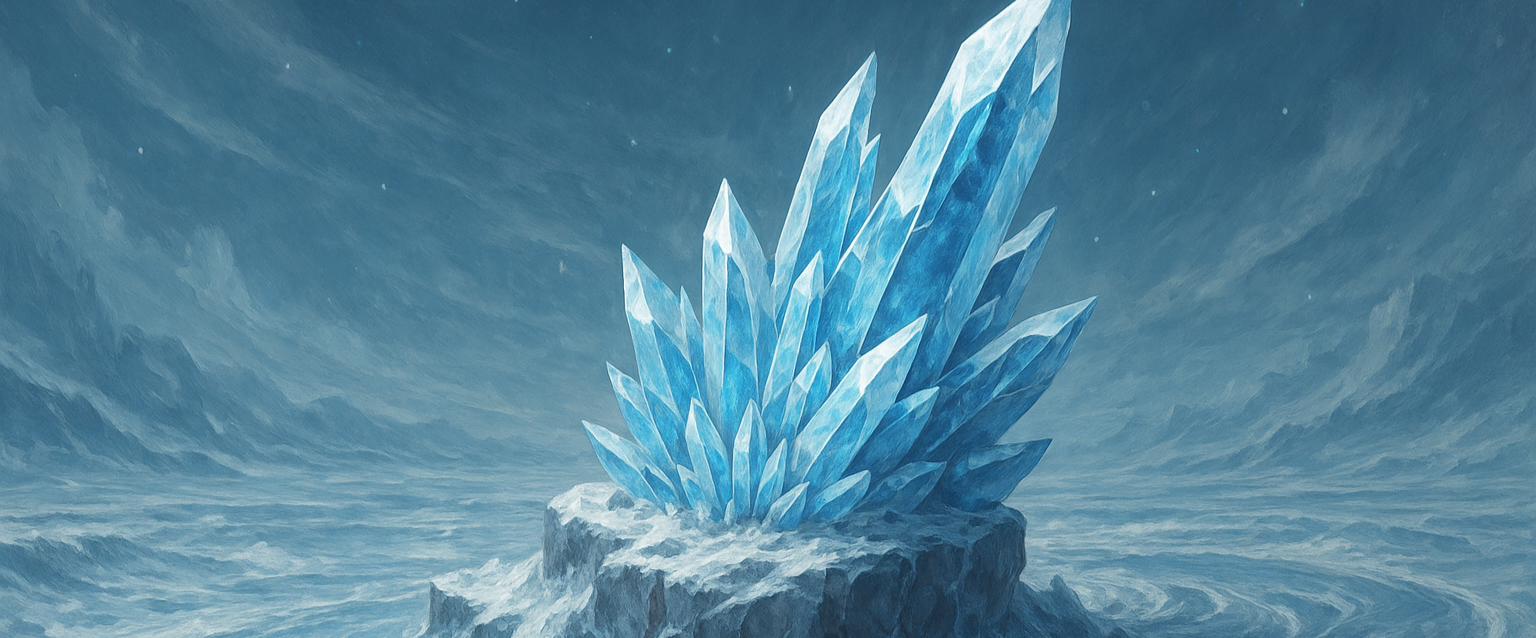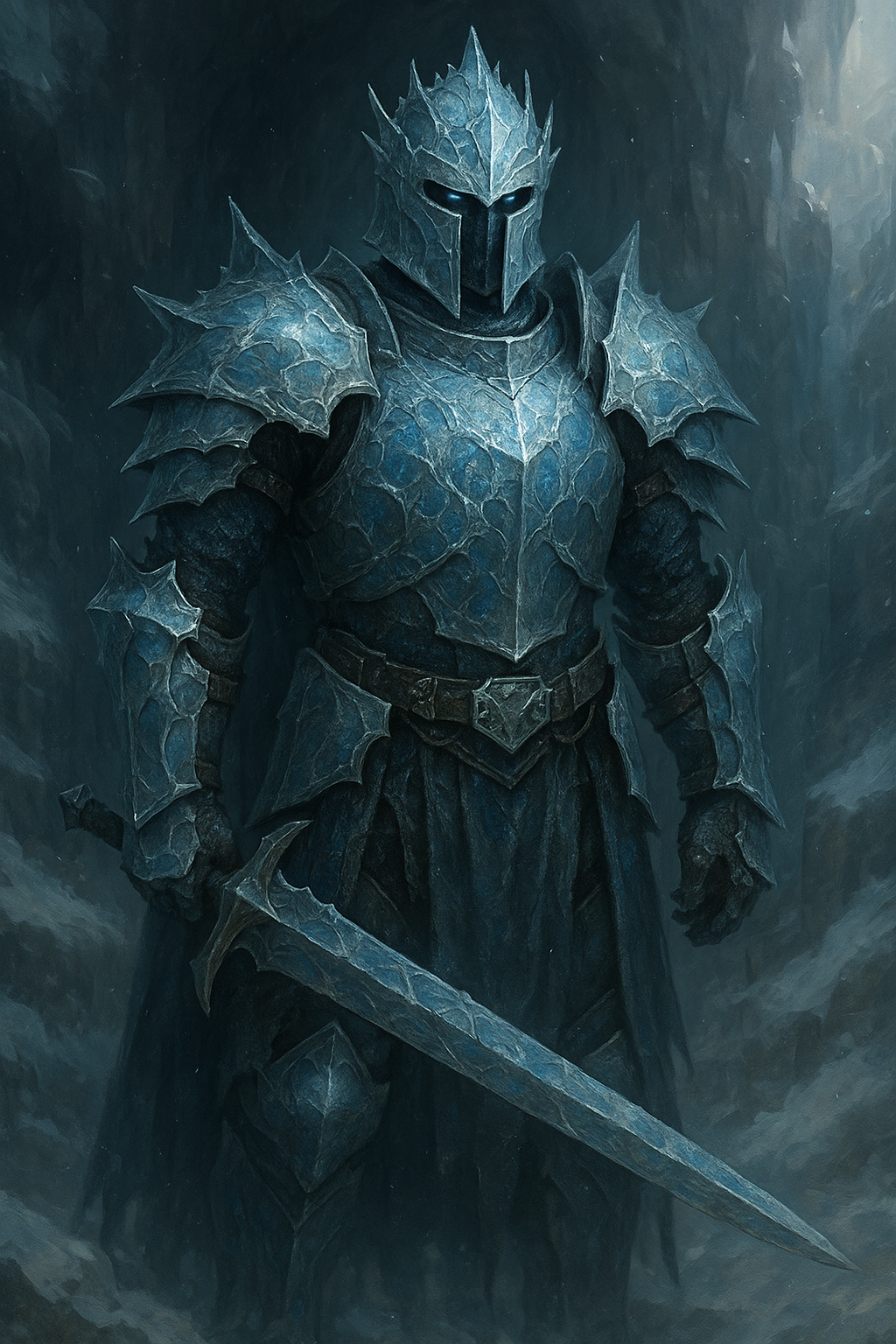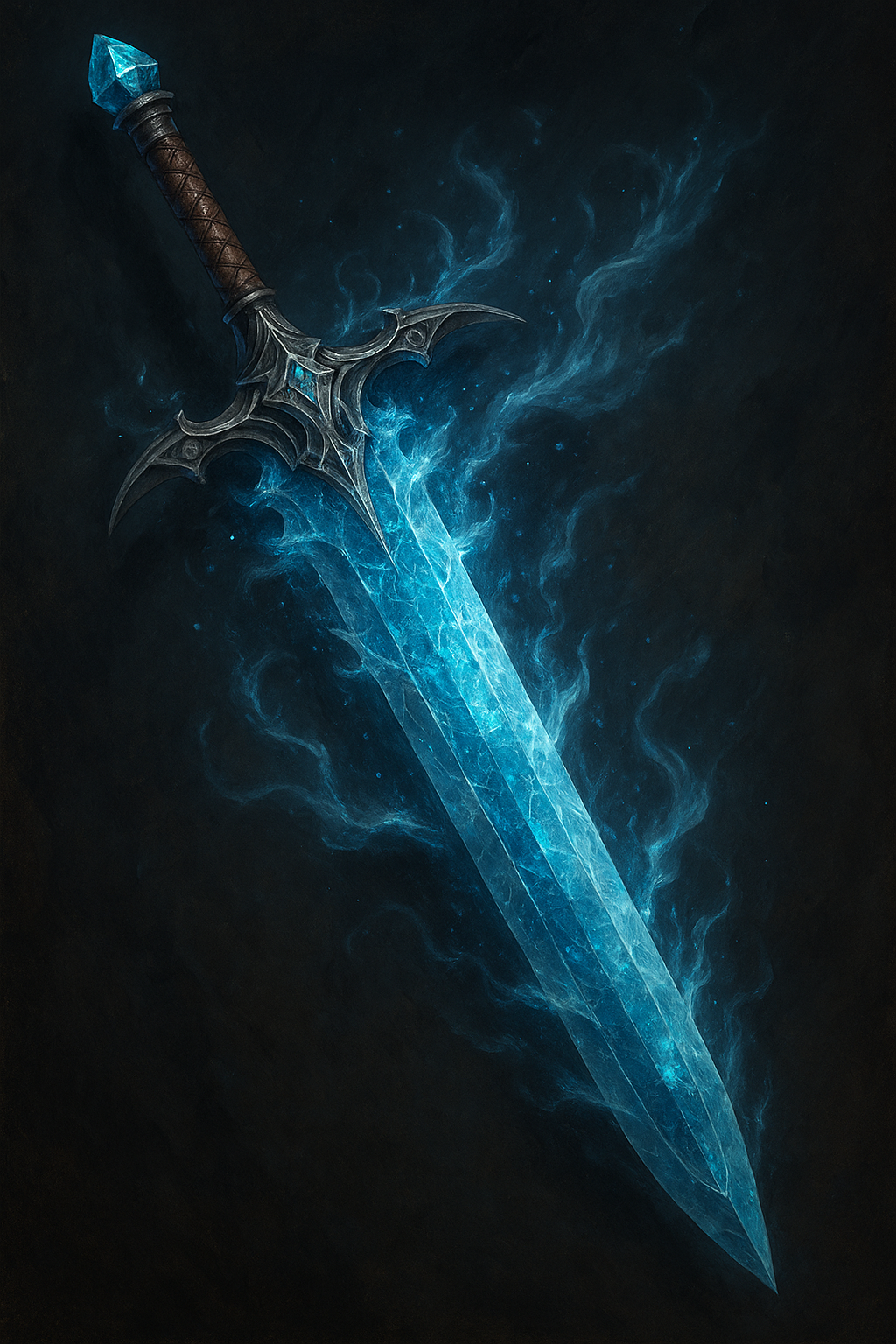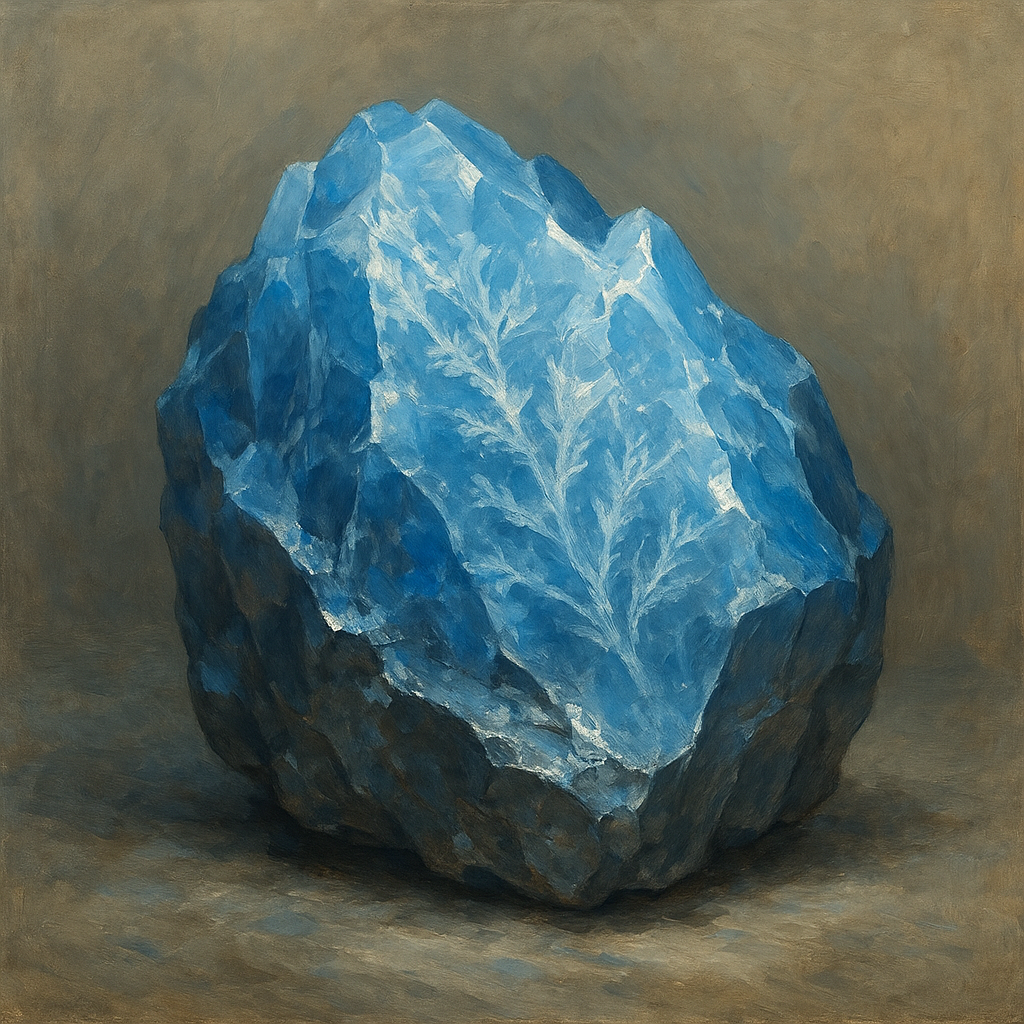Frostvein Ore
Frostvein Ore is a rare, pale-blue metal streaked with white veins, found deep within glacial caves and frozen mountain veins of southern Drakoria and Kalros. Its surface radiates an unnatural chill, and even when forged, it retains a low temperature that can burn like frostbite upon contact. When shaped into armor or weapons, Frostvein’s chill makes it naturally resistant to heat and fire, making it highly valued by warriors and blacksmiths.
Properties
Material Characteristics
Frostvein Ore is a dense, crystalline metal with a pale-blue surface streaked by white veins that resemble creeping frost patterns. It is unnaturally cold to the touch, radiating a chill strong enough to cause minor frostbite with prolonged handling. The ore’s surface is smooth yet jagged along fractures, and when broken, its shards release a burst of misty cold. It possesses a semi-metallic luster that catches the light with an icy shimmer, giving it the appearance of frozen glass rather than stone. Despite its cold nature, Frostvein is incredibly hard—comparable to diamond—and requires enchanted tools to mine and shape. Its structure is resistant to heat and fire but can be shattered by rapid, intense vibrations. In strong magical fields, Frostvein hums faintly, and its veins may glow with a ghostly light, revealing its latent arcane energy. When left exposed to the open air, it forms a delicate layer of rime frost on nearby surfaces, a clear sign of its elemental influence.
Physical & Chemical Properties
Frostvein Ore possesses both physical and magical-chemical properties that make it unique. Physically, it is incredibly hard, dense, and resistant to fire, capable of withstanding extreme temperatures without losing structural integrity. Chemically, it maintains a stable cold aura due to its elemental affinity with frost magic, continually absorbing small amounts of ambient heat. This energy absorption leaves the surrounding environment noticeably colder. The ore is also magically reactive; when exposed to leyline energy or elemental spells, it amplifies cold-based magic and suppresses heat or flame effects in its vicinity. Its internal crystalline structure stores elemental energy, releasing it slowly as frost over time.
Compounds
Frostvein Ore is a key ingredient in several magical compounds and alloys:
Crysteel
A rare alloy forged by combining Frostvein with mithril, resulting in weapons that can freeze wounds and bypass fire-resistant armor.Glacierglass
A translucent arcane glass created using powdered Frostvein, used in scrying mirrors and protective barriers against fire magic.Veinshard Elixirs
Highly illegal alchemical brews made with dissolved Frostvein particles, capable of suppressing magical energy in targets or inducing a frost-induced stasis state.Soulfrost Alloys
Forbidden creations where Frostvein is combined with necrotic energy to craft soul-draining weapons, a secret guarded by rogue forges and dark cults.Geology & Geography
Frostvein Ore is found only in extreme northern regions where glacial magic saturates the land. The richest veins exist deep within the Frostmere Mountains of Kalros and in the glacial caves of southern Drakoria, often guarded by ice elementals or ancient wards left behind by long-dead civilizations. Some deposits have also been discovered near leyline convergences where frost and elemental magic intertwine, but these are far rarer and often unstable. Mining Frostvein is perilous; its deposits are hidden deep within treacherous ice tunnels, and prolonged exposure to the ore’s frost aura can sap the strength and warmth from unprotected miners.
History & Usage
History
Frostvein Ore has been known since the early Calamity Era, first discovered by Kalrosi mountain clans who believed it was the crystallized blood of slain frost elementals. These early societies treated the ore as sacred, forging only ceremonial blades and weapons for clan leaders. It was said that each strike from such weapons carried the wrath of the frozen peaks. Over time, knowledge of Frostvein’s properties spread to Drakoria, where it became prized by smiths for its durability and resistance to fire, finding its way into armor and weapons used against dragons.
During the Calamity Era’s height, Frostvein gained a darker reputation. Rogue forges and warlords learned to corrupt the ore with necrotic magic, producing cursed soul-draining blades. These weapons, known as Frostvein Reapers, left trails of frost where they struck and devoured the life force of those they felled. After the wars, the Order of Arelian declared these practices forbidden, destroying many such weapons and sealing the knowledge of their forging.
In the Harmonium Era, Frostvein became a tightly controlled resource, with mining regulated to prevent the spread of soulforged weapons. Kingdoms like Kalros still use it in ceremonial gear, while Drakoria forges it into high-end military equipment. However, black-market demand remains high, as fragments of Frostvein are still smuggled to alchemists and forbidden smiths seeking to recreate its darker applications.
Legends persist that the largest known vein of Frostvein lies beneath the Frozen Maw, a glacier said to be alive and feeding on those who dare to mine too deeply. Few have returned from expeditions to prove the myth, but the ore’s scarcity keeps adventurers and smugglers risking everything for its power.
Everyday use
Heat Resistance
Weapons and armor forged with Frostvein remain cool, making them perfect for use in volcanic or desert environments.High-Durability Metal
Its structure is incredibly dense, creating blades and shields that withstand extreme temperatures and physical stress.Prestige Material
Nobles often commission Frostvein-crafted weaponry as symbols of wealth and status.Secret Use of Frostvein Ore
Beyond its known properties and forbidden soul-draining applications, Frostvein Ore hides an even darker secret—one known only to a handful of ancient smiths and elemental scholars. When subjected to ritual freezing in the presence of void magic, Frostvein undergoes a transformation into a material called Nullfrost. Unlike its original form, Nullfrost does not simply absorb heat; it consumes all forms of energy, including magic, sound, and even life force within a small radius. Weapons forged with Nullfrost are said to erase what they strike, freezing not only flesh but also severing the target’s connection to magic and even their own soul. Wounds caused by these weapons cannot be healed by divine or arcane means, and in extreme cases, the victim’s very existence is “faded” from magical memory, as though they never were. The process to create Nullfrost is so dangerous it has nearly been lost to history—void magic is notoriously unstable, and mishandling the ore during the transformation can lead to explosions of freezing energy that create dead zones where no magic works. This knowledge is rumored to survive only in a few hidden grimoires and among cults that worship the Shadowed God or other void entities. Because of this, the Order of Arelian classifies Frostvein as a Tier One Restricted Resource, its mining carefully watched to ensure that no large deposits fall into the wrong hands. Yet whispers suggest that a few Nullfrost weapons still exist, hidden away in vaults or lost in the frozen wastelands, waiting to be found.128Fr
327.4 u
Type
Ore
Value
Raw: 5,000 gp per pound
Refined Frostvein Ingots Cost: 10,000 gp per ingot (weighing 2–3 lbs)
Refined Frostvein Ingots Cost: 10,000 gp per ingot (weighing 2–3 lbs)
Rarity
Very Rare
Odor
Faint ozone-like scent mixed with a crisp, icy sharpness, similar to air before a snowstorm.
Taste
Metallic with an intense, numbing cold that can burn the tongue (dangerous to sample).
Color
Pale-blue base with white crystalline veins; faint glacial glow under moonlight.
Boiling / Condensation Point
Approximately 4,200°C (7,600°F) – extremely high, requiring magical forges to vaporize.
Melting / Freezing Point
Melts only at 1,750°C (3,182°F) and refreezes rapidly below -40°C (-40°F) .
Density
9.2 g/cm³
Common State
Solid crystalline ore, always cold to the touch regardless of ambient temperature.







Comments